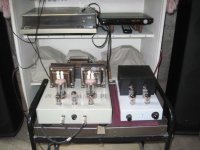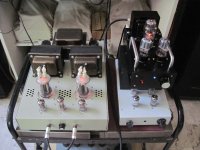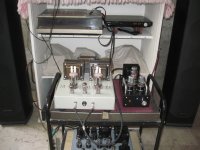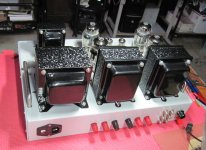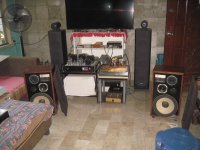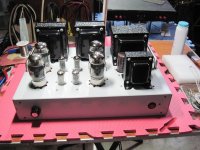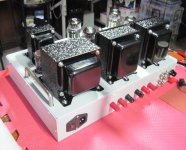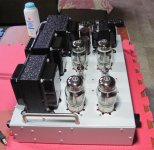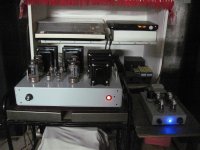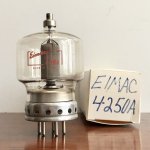The center of the 5894 RF tube plates does the work of gathering the electrons.
The wings get rid of the heat from the working area of the plate.
Why didn't designers and manufacturers make audio tubes that used circular elements?
Take a look at a 4X150A, or other similarly built tubes . . .
They were very Linear; but they were very expensive to manufacture; and required forced air cooling.
Transmitters that were made for Commercial communication, or for Military communication is far different than Audio amplifiers made for home use.
Just my opinions, and my experiences in RF communications, and in home audio amplifiers.
The wings get rid of the heat from the working area of the plate.
Why didn't designers and manufacturers make audio tubes that used circular elements?
Take a look at a 4X150A, or other similarly built tubes . . .
They were very Linear; but they were very expensive to manufacture; and required forced air cooling.
Transmitters that were made for Commercial communication, or for Military communication is far different than Audio amplifiers made for home use.
Just my opinions, and my experiences in RF communications, and in home audio amplifiers.
Yes it does, and that picture shows it very clear, thank you!jcalvarez,
I am attaching a drawing.
Look at the cathode, each side is relatively flat.
Look at the curve shape of grid g1
Look at the curved shape of grid g2
Look at the curved shape of the plate (in the paths that are set by the beam formers).
Look at the electron path lengths from the cathode all the way to the plate.
Are the electron path distances equal from cathode to g1, g1 to g2, g2 to the plate?
It seems that reasonable care in design and production have made the majority of the electron paths roughly equal through each of the field potentials along the way (cathode to g1, g1 to g2, g2 to plate).
Does that answer your question?
Equal lengths are good for RF, OK. But we are talking about audio, where the Transit Time does not apply.
But, Linearity Does count. We get good linearity because of the similary paths and similar path lengths of all the electrons.
Linearity, not just for RF, but Linearity for audio.
Does that answer your question(s)?
"Secrets" of dead engineers; Western Electric, RCA, EiMac, etc.
The unfortunate thing about a single 5894 in push pull, is that it is only made for Beam Power mode.
A single 5894 in push pull, can not be used in Ultra Linear mode, and cannot be used in Triode Wired mode.
Make it with two screens, and an extra screen connection pin . . . and think of the possibilities.
A single 5894 in push pull, can not be used in Ultra Linear mode, and cannot be used in Triode Wired mode.
Make it with two screens, and an extra screen connection pin . . . and think of the possibilities.
this is because of the low G2 voltage specs for the 832, 829b and simmilar tubes, i never liked ultra-linear mode really anyway, a pure pentode sounds better to my ears....The unfortunate thing about a single 5894 in push pull, is that it is only made for Beam Power mode.
A single 5894 in push pull, can not be used in Ultra Linear mode, and cannot be used in Triode Wired mode.
Make it with two screens, and an extra screen connection pin . . . and think of the possibilities.
Attachments
i have the 4-250 with circular plates...they are also good for audio...Why didn't designers and manufacturers make audio tubes that used circular elements?
Attachments
 A bit of time out for the members who can’t control themselves or obey the rules.
A bit of time out for the members who can’t control themselves or obey the rules.Argue the topic, not the person.
why should they be sensitive?, the beam forming plates are another implementation of the G3 spiral grids...What about tubes with beam-forming plates? Would they be less sensitive to the anode shape?
My point was, if round is indeed the best shape, then beam power tubes only need part of the anode being round, therefore you can optimise the rest of the anode for other things, like power dissipation, manufacturability, mechanical strength etc. Sensitive was probably not the right word.why should they be sensitive?, the beam forming plates are another implementation of the G3 spiral grids...
This is just a guess, I have no experience with valve design and manufacturing.
Apologies if it's already been mentioned, but isn't the Nuvistor the answer to all this?
Perhaps a whole new world of problems/ compromises to consider
Perhaps a whole new world of problems/ compromises to consider
Am not totally sure, i have never opened and checked, i only have seen some developement drawings of the coaxial transmitting triode ITK90.BTW
I dont know the type of DH cathode with "rounded" shape?
Simply it is not acheivable?
When i used this tube for the first time i was not aware that this was the first time this tube was ever used in a rf-generator. No wonder i got it so cheap from Thomson and that they where so interrested about my experiences with it,. Would they have told me that beforehand i sure would not have risked to be theyr guenniepig.
Last edited:
TonyTechson,
I am not looking for medium to high power, I am looking for low power; no global negative feedback; sometimes with or without local negative feedback; simple circuits; and Sound Finesse.
I prefer to use Pentodes and Beam Power tubes in Triode Wired mode. I like the simplicity of Indirectly heated tubes (including triodes such as 6CK4).
Otherwise, I would try using the pair of 5894 that I have to build 2 push pull Mono-Blocks (but I would be restricted to using them in Beam Power mode).
The same goes for the 832 and 829B (I would need 2 tubes just to do a single push pull Mono-Block in Triode Wired mode).
Yes, your 4-250 has a circular plate . . . But both g1 and g2 are circular bird cage grids.
I am not sure whether the Thoriated Tungsten Filament is approximately circular or not; can you look at it and tell me if it is, Please?
I used a 4-65A with circular plate, circular g1 birdcage, and circular g2 birdcage.
I can not see the thoriated tungsten filament to see if it is approximately circular or not.
I experimented with the 4-65A, I grounded the plate (no plate current), and used the g2 grid as a Plate (10 Watt dissipation Screen).
Another Low Power amplifier, as usual for me.
I am considering using the 4X150A, not all that pretty.
But I would use it in a different way . . . Ground the plate; use the 12W dissipation Screen as a Plate.
Yes, I have strange ideas, I admit.
"I do not want to climb Mt. Everest, I want to climb K2"
K2 has killed less people than Mt. Everest, but only because only a Very few strange people have ever attempted to climb K2.
Have fun in the Philippines!
I have been there, many decades ago.
I am not looking for medium to high power, I am looking for low power; no global negative feedback; sometimes with or without local negative feedback; simple circuits; and Sound Finesse.
I prefer to use Pentodes and Beam Power tubes in Triode Wired mode. I like the simplicity of Indirectly heated tubes (including triodes such as 6CK4).
Otherwise, I would try using the pair of 5894 that I have to build 2 push pull Mono-Blocks (but I would be restricted to using them in Beam Power mode).
The same goes for the 832 and 829B (I would need 2 tubes just to do a single push pull Mono-Block in Triode Wired mode).
Yes, your 4-250 has a circular plate . . . But both g1 and g2 are circular bird cage grids.
I am not sure whether the Thoriated Tungsten Filament is approximately circular or not; can you look at it and tell me if it is, Please?
I used a 4-65A with circular plate, circular g1 birdcage, and circular g2 birdcage.
I can not see the thoriated tungsten filament to see if it is approximately circular or not.
I experimented with the 4-65A, I grounded the plate (no plate current), and used the g2 grid as a Plate (10 Watt dissipation Screen).
Another Low Power amplifier, as usual for me.
I am considering using the 4X150A, not all that pretty.
But I would use it in a different way . . . Ground the plate; use the 12W dissipation Screen as a Plate.
Yes, I have strange ideas, I admit.
"I do not want to climb Mt. Everest, I want to climb K2"
K2 has killed less people than Mt. Everest, but only because only a Very few strange people have ever attempted to climb K2.
Have fun in the Philippines!
I have been there, many decades ago.
the D3a did not have round plates, but was well received.....
so is the 12HL7,
the 5894, a dual pentode, sounds fantastic in my amp, go look at their plates...
i attached pictures of tubes that i actually used in my amps...
With the 5894 are using one tube in push pull?
better than the 829b in ingle ended, push pull is excellent...With the 5894 are using one tube in push pull?
what i liked with the 5894 is that it had only a single cathode structure so that matching between sections are bery good indeed..
oh yes, one tube for push pull, those unfamilliar with the 5894 may think of the amp as single ended...With the 5894 are using one tube in push pull?
Haven't really looked at plate shapes in the past, so I just went through part of my tube stash and listening notes to see if there's any patterns. The tubes I like the most seem to be split between round and box style plates. ECC40, 56, and 27 are round, on the other hand 26, 3A5, and grey glass 12SN7 are thin rectangular boxes. Not sure if there's anything to it since I've heard bigger differences between some types of 12SN7 tubes than I have with a 56 vs. a grey glass 12SN7.
I agree, I haven’t heard any qualitative differences between round plate vs flat. As you say, different versions of the same tube vary by manufacturer, date, etc. Most of the 6sl7 tubes of the past were made with round plates and yet they sounded quite different from one another. Not all of them sound good, the GE 6sl7 with shiny plates is pretty bad IMO. Round plates didn’t save that one!Haven't really looked at plate shapes in the past, so I just went through part of my tube stash and listening notes to see if there's any patterns. The tubes I like the most seem to be split between round and box style plates. ECC40, 56, and 27 are round, on the other hand 26, 3A5, and grey glass 12SN7 are thin rectangular boxes. Not sure if there's anything to it since I've heard bigger differences between some types of 12SN7 tubes than I have with a 56 vs. a grey glass 12SN7.
Philips made a variation of this tube, the YL1320, for conduction cooling (heatsink cooling) that would be quite usable for audio.Take a look at a 4X150A, or other similarly built tubes . . .
They were very Linear; but they were very expensive to manufacture; and required forced air cooling.
Absolute seal temp of 250°C would allow for a comparable small heatsink at up to 150W anode power.
- Home
- Amplifiers
- Tubes / Valves
- Do cylindrical plate, round anode tubes sound better?
